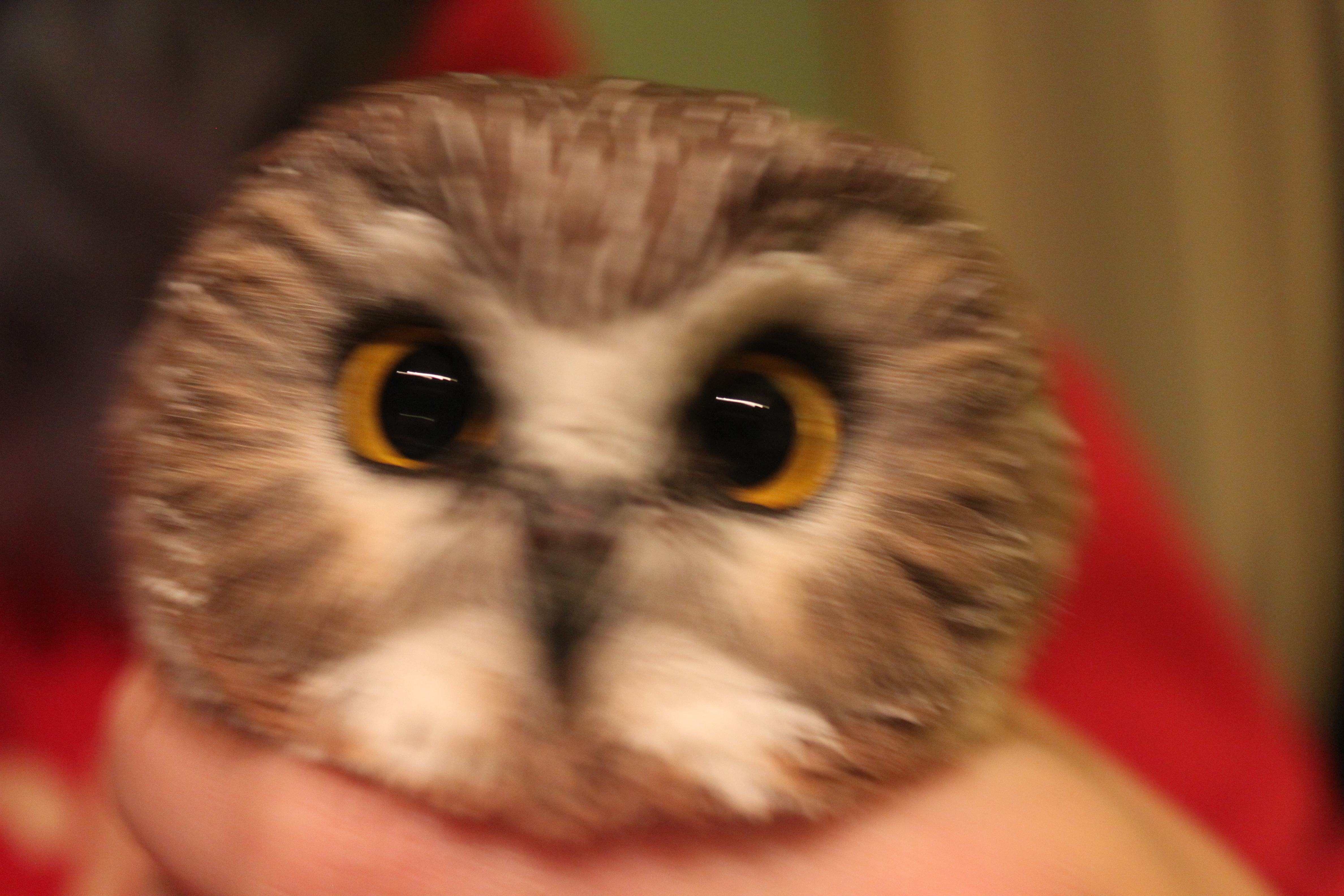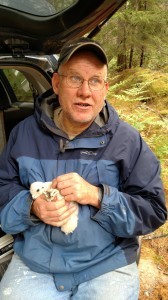above: Student Brittany Peck holding a saw whet owl
The October countryside echoes with a strange piercing tooting. We trudge through the darkness toward the sound. The star-filled sky twinkles above as we move slowly down the road, and turn onto an old tractor trail. We can see our breath in the crisp cool air, and feel the autumn chill on our faces. The red lights from our headlamps dance over the spooky landscape as we quietly make our way down the bumpy terrain, toward the source of the sound. The crunch of our feet on the partially-frozen ground is the only sound we make as we zero in on the calls. We have only journeyed halfway to our destination when the local coyotes add in their mournful wails. Finally, the trail through the brushy field narrows and we arrive at a series of four nets, strung end-to-end along the trail, with a predator call blasting between the second and third nets.
As silently as possible we move along the nets quickly, scanning each one.We soon discover two tiny owls entangled in the delicate fabric. Gently we extract each bird and carefully place them in a mesh cloth bag for transport. The direction the owl was coming from, the net it was caught in, which pocket of the net it was ensnared in, and the distance from the audio lure is all recorded on a data sheet. Then, as quietly as possible, we sneak back down the trail with our quarry safely held in bags. The broadcasted calls from the audio lure fade with every footstep.
This is a typical nightly occurrence on any given day in October at the saw whet owl banding station. Once we return to the house, the small owls will then be checked for bands. If they already possess a band, the number will be recorded to determine the history of that individual owl; if the owl does not possess a band it will soon have its own ankle bling to show its fellows.
Once the health, sex, age, and other measurements of the tiny owl have been recorded, each bird is placed back in the mesh bags and placed in the dark for at least five minutes. Once the owl has had time to adjust to the darkness, the bird is taken to a predetermined location, and released.

Saw whet owls are the smallest owls in the Northeastern United States, with the average mass being less than half a roll of nickels. The saw whet owl banding station was officially opened at the VIC on 21 October 2011, and ran until 11 November. During the first season, the dedicated staff, consisting mainly of Paul Smith’s College students, caught just 20 owls. During the first week, we ran the station with a big boom box and mist nets that were too big for our tiny quarry. But within a week, the station had come up to speed and quickly aligned itself with a network of stations throughout the country.
By 2014, the station was moved from the VIC to Dickinson Center, New York – approximately 24 miles northwest of its original location. The belief that most of the owls migrate along the St. Lawrence River Valley, and avoid the rough terrain of the Adirondacks, spurred the move. It wasn’t long before that theory was confirmed. During the three years the station was at the VIC, 103 owls were captured and during the next two years, at the new location, an additional 147 owls were banded. We caught a record 81 owls during the 2015 season and are hoping to add to the record this fall.
The station is operated by Mark Manske, the owner of Adirondack Raptors, and adjunct professor on campus. He is always looking for volunteers for the next banding season. If you are interested in participating in the station next fall contact Mark through his college e-mail (mmanske@paulsmiths.edu).
Mark Manske established Adirondack Raptor Inc. in 2008 and is the sole owner of the company. He was a public school educator for 27 years, a wildlife rehabilitator from 1994 through 2002, a master falconer since 2003, a master raptor bander since 1988, and a licensed nuisance wildlife control agent from 2008 through 2012. He has also been adjunct professor at Paul Smith’s College since 2007. Mark has published stories in his column in the EMBARK, a periodical that is published every other month by the Adirondack Daily Enterprise in Saranac Lake. He has published several articles on birds of prey in scientific journals through the years. Mark trained under the tutelage of Drs. Frederick and Frances Hamerstrom (graduate students of Aldo Leopold and world renowned biologists) in the early 1980s at the University of Wisconsin at Stevens Point.


